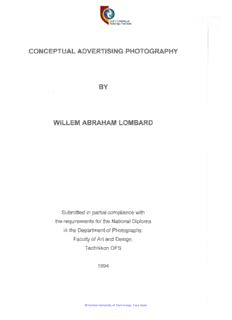
conceptual advertising photography by willem abraham lombard PDF
Preview conceptual advertising photography by willem abraham lombard
CONCEPTUAL ADVERTISING PHOTOGRAPHY BY WILLEM ABRAHAM LOMBARD Submitted in partial compliance with the requirements for the National Diploma in the Department of Photography, Faculty of Art and Design, Technikon OFS 1994 © Central University of Technology, Free State CONTENT PAGE 1. Introduction Purpose of advertising photography ................. 01 2. The history of the origin of photography and its progress in the world ................................. 03 3. A look at advertiSing and it's application .' ............. 05 4. A discussion of photographers work in general ........ 08 5. Equipment used in the studio. . .. . . . . . . . . . . . . . . . . . . . .. 13 6. A discussion of the author's work ..................... 18 7. Conclusion ............................................ 31 BIBLIOGRAPHY © Central University of Technology, Free State LIST OF ILLUSTRATIONS Figure 1 Cocaine, DDB Needham world-wide, 1986 Figure 2 Gary Perweiler, -"Clamp with soap bubble", 1989 Figure 3 Michael Freeman - "History of Photography" Figure 4 BBD : Goatham and Gibson - "United", 1990 Figure 4.1 Lipsticks, "Still-life" - 1990 Figure 4.2 Denim Jeans, "Still-life" - 1990 Figure 5 Cardoza and Pizzarello - "Heineken Beer", 1990 Figure 6 Shiki - "Beer advertising" Figure 7 George Kamper - " Michael D'Angelo and Coke - 1990 Figure 8 Haruo Wataba - "Heineken Beer", 1991 Figure 9 Chuck Fish-Bein - "Still-life", 1989 Figure 10 4 x 5 Illustration Michael Langford Advanced Photography Figure 10.1 Lights taken from Michael Langford Advanced Photography Figure 10.2 Fibre optics taken from Michael Langford Advanced Photography © Central University of Technology, Free State LIST OF AUTHOR'S WORK Figure 1 "Grapetizer" - 1994 Figure 2 "Douglas Green" - 1994 Figure 3 "Speedo" - 1994 Figure 4 "Windhoek Light Beer" - 1994 Figure 5 "Poison" - 1994 Figure 6 "Yardley" - 1994 Figure 7 "Optical Alure" - 1994 Figure 8 "ESP" -1994 Figure 9 "Philips" - 1994 Figure 10 "Vin Doux" - 1994 Figure 11 "Tweed" - 1994 Figure 12 "Diet Coke" - 1994 © Central University of Technology, Free State CHAPTER 1 © Central University of Technology, Free State ~n - introduction to advertising and it's purpose in -the business world. Visual communication is of the utmost importance in the market place. Product services and publications all depend on it, and photography is the most successful in the advertising area. Fig. 1. "Advertising photography is commercial art: and commercial art is public communication" (Gary Perweiler p.2. Secrets of studio still life) Commercial photography plays an important role in the displaying of mass-produced consumer goods which are often dull and uninteresting and calls for the creative edge of advertising photographers to inject the maximum visual interest possible. Advertising photography has established new standards of imaginative treatment to uninteresting objects. Fig. 2. PURPOSE OF ADVERTISING PHOTOGRAPHY Advertising photography is illustrative photography that embodies or expresses a predetermined idea. It is to sell it's subject matter either literally by making the viewer want to purchase the product or indirectly by creating a positive attitude towards the activities presented and to introduce new products and organisations as prolific ally strong, exiting and quality wise as possible (e.g. Introduction of Cellular phone systems) © Central University of Technology, Free State Photographic illustrations are used in more than just newspaper and ~ magazine advertisements. They are a major part of catalogue's, brochures and promotional literature as well as posters. In technique and application advertising is probably the most all encompassing area in the field of photOgraph~ Fig.1 Fig.2 2 © Central University of Technology, Free State CHAPTER 2 © Central University of Technology, Free State r THE HISTORY OF THE ORIGIN OF PHOTOGRAPHY AND ITS cs> PROGRESS IN THE WORLD Since the inventions of Louis Daguerre and Henry Fox Talbot had been announced in 1839, photography has evolved through ± 150 years of existence. It's uses have been numerous and varied. Photography gradually took over the main function of art - recording of factual visual information. Instead of having a portrait painted, people used the light of day to create the first photographs. It became possible to see first hand visuals of far away places and battles. The Daguerreotype and later the Calotype process were the first step in the evolution of photography. Later followed by the gelatine emulsion in the 1880's making photography possible for everyone with much of the credit going to George Eastman and his Eastman Kodak company with its roll film. The Eastman Kodak company knew very early who would be it's main clientele and advertised accordingly, "A collection of these pictures may be made to furnish a pictorial history of life as it is lived by the owner, that will grow more valuable every day that passes." Encyclopedia of Practical Photography, p. 30, Kodak. Much of the success of photographs depended on newspapers and magazines which kept people up to date with current happenings. © Central University of Technology, Free State · These magazines and newspapers also formed a new employment for photographers in the 1920's - namely Advertising. In 1842 the new profession of portrait photography took over from illustrators and painters and earning money with these photographs. E.g. Desderi's Carte Devistas 1854. Advertisements with photographic images started appearing E.g. motorcars, cameras (Fig 3). Photographers started to specialise in commercial photography. After the First World War commercial photographic images were on the increase. Photographers had become the popular choice for illustration of advertising and other illustrations in books, posters and newspapers. Magazines like Queen and Nova of that era encouraged photographers to strive for bolder and more dramatic images. Publishing groups and advertising agencies started running their own photographic studios although freelances were still commissioned for important jobs. Photography has taken over as the most popular and exciting medium for advertising with new development every day. (E.g. Digi~ computerised images.) © Central University of Technology, Free State
Description: